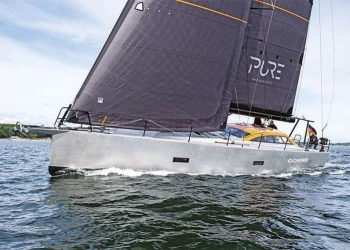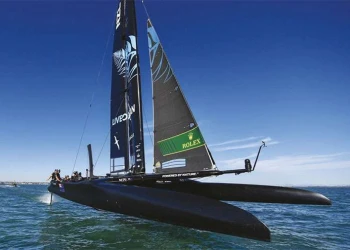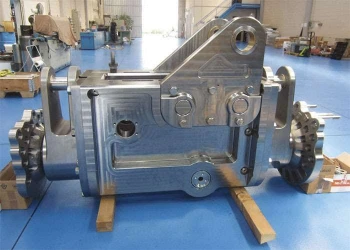
Brad Marsh joins Doyle Sails from the SailGP circuit
Brad Marsh joins Doyle Sails from the SailGP circuit
For four years Brad Marsh, now chief technology officer at Doyle Sails, arguably had one of the most stressful jobs in international sailing. As technical director for the SailGP circuit, he was responsible for the logistics of moving the event infrastructure from venue to venue around the world against immutable deadlines, setting up the onshore facilities and then overseeing the technical crews that maintain the fleet of F50 foiling catamarans at the centre of the sailing spectacular.
Throw in a global pandemic with its attendant supply chain and communications disruptions and the challenge becomes mind boggling. ‘It was a wild ride,’ he concedes. Yet, even as the event and the number of global venues grew ever more complex, the team he led thrived under the pressure.
However, with a professional sailing resumé that includes the America’s Cup, Volvo Ocean Race, TP52 and maxi circuit racing, the SailGP “circus master” role exposed a personal problem: while tackling the multi-dimensional demands of the job satisfied his passion for problem-solving, it came at the expense of his passion for sailing.
Now, by joining Doyle Sails, Marsh will combine both passions in a tidy solution that benefits the company and his own ambitions.
Finding that balance between a stimulating business path and highlevel sailing has occupied Marsh’s imagination since leaving school. ‘While I was at university, I trained as a rigger and worked part-time at NZ Rigging,’ he says. ‘I went to university, so that I could go sailing as often as I liked. I worked as a rigger so that I could pay for university.’
It was a typically pragmatic solution, which furthered his professional sailing career and gave him a business degree, majoring in marketing and information systems. ‘It meant I took five years over a fouryear degree,’ he says – but he ticked off multiple objectives in the process.
When sport went into recess during the Covid lockdowns, Marsh was involved in a piece-by-piece analysis of SailGP. ‘The whole operation was heavily critiqued and analysed, which led to a total recalibration.
‘It made me realise how much I enjoy business analytics and working with a team with plenty of robust discussions. Once the SailGP re-start was up and running again, I knew I would be moving on, because to a large extent I felt my job was done.
‘That is when the conversation with Doyle Sails began about whether I would apply the same vision and processes to their design and project management teams, while also taking on the technology development role.
‘There is an opportunity between selling the sail and building the sail where we can make strides in developing new technology and that is the area I will be exploring. Joining the senior leadership team is also a chance to work with Doyle Sails globally and the industry to make sure we make the right steps going forward to capitalise on the good work that has already been done.
‘The interesting thing for me is that over the past 15 years, Doyle Sails has led some of the biggest changes in sailmaking, sail trimming and sailing. Right back to the beginning of Stratis and the generational developments that have continued with that technology. Add Cableless Code Zeros and external cable furling sails. That led to Structured Luff, which was another great step forward from the design team that has been accepted, respected and copied by the industry.’
And Doyle Sails is set to change the world of sailmaking again with a new development in which Marsh has been actively involved. While the details are yet to be revealed, the new product, called HYBRID, is already tracking well in tests.
‘It is going to be the next generation in lightweight sails,’ says Marsh. ‘We will see it in the Grand Prix market first and then watch it migrate into the superyacht and performance racing markets.’
Pointing to the impact these developments have had on the wider industry, he says they have enabled significant improvements across the full spectrum of yacht design. ‘As you reduce sailplan loads, the mast-makers and boatbuilders enjoy the benefits. The boats become lighter, more responsive, more enjoyable to sail.’
As a Doyle Sails customer at SailGP, Marsh recounts that meeting exacting sponsor demands for improved branding on sails was a headache until Doyle Sails was able to offer him a solution with their digital printing technology, SailArt.
‘SailArt is lighter, brighter, more cost effective and better for the environment without the need for toxic paint systems.’
To meet continuing growth in demand, Doyle Sails has had to expand their manufacturing capacity in Auckland, New Zealand – opening a second facility for “small boat” sails. Small boats are defined as under 25m. Marsh chuckles: ‘A boat like a Volvo 70 is now a small boat’.
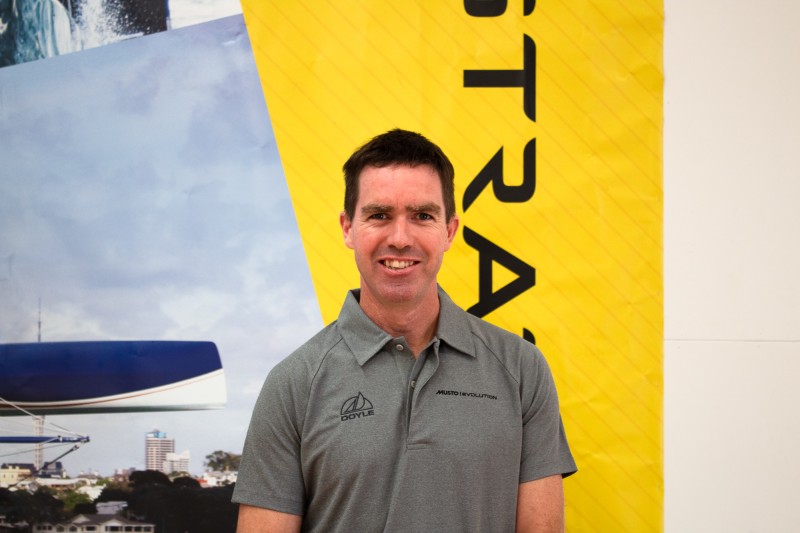
The headquarters focuses on the manufacture of custom Stratis membranes to supply the worldwide network of Doyle Sails lofts. ‘Every single Stratis sail starts its winning journey in this building,’ he says.
In the climate-controlled area, wide gantries travel backwards and forwards across three huge tables, laying a complex matrix of technora or carbon fibres onto prepreg film to correspond with the sail load paths.
A recent development has seen Doyle integrating as much detailing and patching as possible – including batten pockets – within the sail structure as opposed to postproduction stitching and gluing. This reflects an ongoing determination to constantly seek improvement down to the smallest detail.
‘Old-style external batten pockets had performance disadvantages,’ says Marsh. ‘They meant there was an aerodynamic inconsistency from one tack to the other, plus the exposure created abrasion issues. Sealing internal pockets at the centre of the structure makes the sail totally symmetrical on either tack and is more durable. ‘Ironing out this process was something Doyle Sails worked on through the Covid period,’ Marsh explains. ‘Now 90 per cent of our sails have internal patching and detailing.’
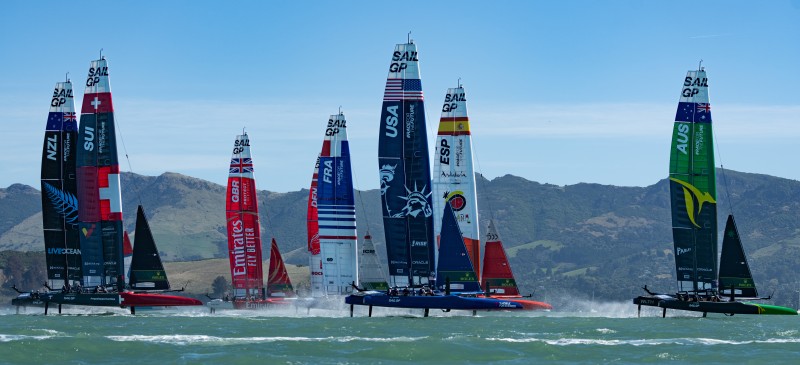
Achieving this development does introduce an interruption in the process, while the internal patches and pockets are positioned. However, in addition to streamlining the finished product, it also streamlines valuable time on the loft floor by reducing the amount of manual finishing.
This level of attention to detail applies not just to the product, but the process as well. Look above the production area and instead of the customary maze of metal air-conditioning ducts floats a cloud of white tubing made from lightweight spinnaker material, complete with a line of vents neatly spaced along its length. ‘Making our own ducting enabled us to recycle or upcycle material and repurpose it to something relevant to our process,’ he says. ‘Like the move to SailArt, it is also a way we can improve our sustainability profile, which is important to us.’
In terms of building sails, this main facility concentrates largely on superyacht and grand prix projects. ‘Those two areas present the greatest potential for development and therefore offer the best prospect of trickle-down to benefit all our sails,’ Marsh notes.
Yards and owners increasingly realise the value of having Doyle Sails’ design team around the table at the conception stage of a superyacht project to exploit the full load-reduction benefits of their technology. This means those conversations can sometimes begin five years or more before the sails are actually built.
‘We are currently working on a sloop where the mainsail luff will be just short of 100m,’ says Marsh. ‘That will occupy the full length of the main loft floor and we will have to clear all other finishing work to accommodate that single sail. At other times we might have a dozen or more projects on that floor. Amazing things are happening in the Superyacht world.’
Given the massive and ongoing investment Doyle Sails has made in Stratis, what happens if Marsh, in his role as chief technology officer, finds a new and better way to do things? ‘As a previous customer and somebody who has been involved in other parts of the industry, I have seen that Doyle Sails has always been quick to adapt and adopt new technology,’ he smiles.
‘Many of their technology jumps have severely challenged their manufacturing processes, but that hasn’t stopped them. Driving major change is their normal. It could be that in the future this room is completely different,’ he says, looking at the laminating machines endlessly travelling back and forth as they weave their webs of hightech fibre.
‘We don’t know yet, of course, but there could be robots, artificial intelligence processes ... The marine industry has always been open to progress and has often led change. If you have a business culture that i s hesitant or closed to change, you are never going to move forward.’
Clearly relishing the prospect, Marsh says when he left SailGP, he was determined to stay in the marine industry. ‘I enjoy the environment. I enjoy exploring new concepts and ideas. And, best of all, I get to go racing again. It is such a fun time right now with maxi yachts VMG sailing, TP52s that are still rapidly developing, progress with foiling classes of all sizes.’
In keeping with their “By Sailors, For Sailors” credo, Doyle Sails actively recruits frontline grand prix sailors in the knowledge that these circuits are both their major shopfront and their best development laboratory.
‘It is important for us to be out there sailing,’ says Marsh. ‘All our processes are set up to be working remotely, so we can be embedded with sailing campaigns and feeding our ideas and everything we are learning back here. That is definitely within the scope of my role,’ he nods. ‘I will definitely be out there.’



